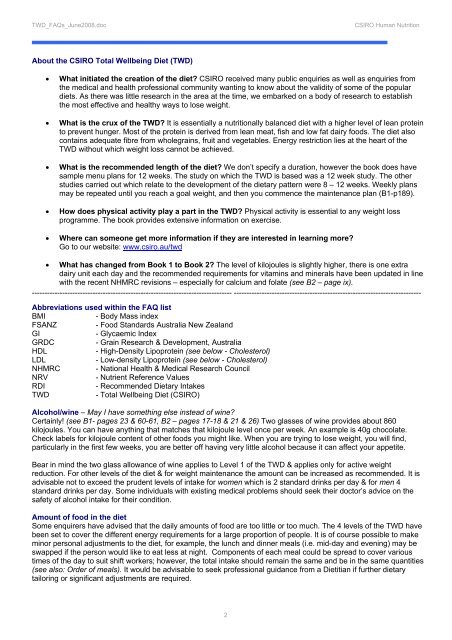The CSIRO Total Wellbeing Diet Frequently Asked Questions
The CSIRO Total Wellbeing Diet Frequently Asked Questions
The CSIRO Total Wellbeing Diet Frequently Asked Questions
Create successful ePaper yourself
Turn your PDF publications into a flip-book with our unique Google optimized e-Paper software.
TWD_FAQs_June2008.doc <strong>CSIRO</strong> Human Nutrition<br />
About the <strong>CSIRO</strong> <strong>Total</strong> <strong>Wellbeing</strong> <strong>Diet</strong> (TWD)<br />
• What initiated the creation of the diet? <strong>CSIRO</strong> received many public enquiries as well as enquiries from<br />
the medical and health professional community wanting to know about the validity of some of the popular<br />
diets. As there was little research in the area at the time, we embarked on a body of research to establish<br />
the most effective and healthy ways to lose weight.<br />
• What is the crux of the TWD? It is essentially a nutritionally balanced diet with a higher level of lean protein<br />
to prevent hunger. Most of the protein is derived from lean meat, fish and low fat dairy foods. <strong>The</strong> diet also<br />
contains adequate fibre from wholegrains, fruit and vegetables. Energy restriction lies at the heart of the<br />
TWD without which weight loss cannot be achieved.<br />
• What is the recommended length of the diet? We don’t specify a duration, however the book does have<br />
sample menu plans for 12 weeks. <strong>The</strong> study on which the TWD is based was a 12 week study. <strong>The</strong> other<br />
studies carried out which relate to the development of the dietary pattern were 8 – 12 weeks. Weekly plans<br />
may be repeated until you reach a goal weight, and then you commence the maintenance plan (B1-p189).<br />
• How does physical activity play a part in the TWD? Physical activity is essential to any weight loss<br />
programme. <strong>The</strong> book provides extensive information on exercise.<br />
• Where can someone get more information if they are interested in learning more?<br />
Go to our website: www.csiro.au/twd<br />
• What has changed from Book 1 to Book 2? <strong>The</strong> level of kilojoules is slightly higher, there is one extra<br />
dairy unit each day and the recommended requirements for vitamins and minerals have been updated in line<br />
with the recent NHMRC revisions – especially for calcium and folate (see B2 – page ix).<br />
------------------------------------------------------------------------------- --------------------------------------------------------------------------<br />
Abbreviations used within the FAQ list<br />
BMI - Body Mass index<br />
FSANZ - Food Standards Australia New Zealand<br />
GI - Glycaemic Index<br />
GRDC - Grain Research & Development, Australia<br />
HDL - High-Density Lipoprotein (see below - Cholesterol)<br />
LDL - Low-density Lipoprotein (see below - Cholesterol)<br />
NHMRC - National Health & Medical Research Council<br />
NRV - Nutrient Reference Values<br />
RDI - Recommended <strong>Diet</strong>ary Intakes<br />
TWD - <strong>Total</strong> <strong>Wellbeing</strong> <strong>Diet</strong> (<strong>CSIRO</strong>)<br />
Alcohol/wine – May I have something else instead of wine?<br />
Certainly! (see B1- pages 23 & 60-61, B2 – pages 17-18 & 21 & 26) Two glasses of wine provides about 860<br />
kilojoules. You can have anything that matches that kilojoule level once per week. An example is 40g chocolate.<br />
Check labels for kilojoule content of other foods you might like. When you are trying to lose weight, you will find,<br />
particularly in the first few weeks, you are better off having very little alcohol because it can affect your appetite.<br />
Bear in mind the two glass allowance of wine applies to Level 1 of the TWD & applies only for active weight<br />
reduction. For other levels of the diet & for weight maintenance the amount can be increased as recommended. It is<br />
advisable not to exceed the prudent levels of intake for women which is 2 standard drinks per day & for men 4<br />
standard drinks per day. Some individuals with existing medical problems should seek their doctor’s advice on the<br />
safety of alcohol intake for their condition.<br />
Amount of food in the diet<br />
Some enquirers have advised that the daily amounts of food are too little or too much. <strong>The</strong> 4 levels of the TWD have<br />
been set to cover the different energy requirements for a large proportion of people. It is of course possible to make<br />
minor personal adjustments to the diet, for example, the lunch and dinner meals (i.e. mid-day and evening) may be<br />
swapped if the person would like to eat less at night. Components of each meal could be spread to cover various<br />
times of the day to suit shift workers; however, the total intake should remain the same and be in the same quantities<br />
(see also: Order of meals). It would be advisable to seek professional guidance from a <strong>Diet</strong>itian if further dietary<br />
tailoring or significant adjustments are required.<br />
2
















